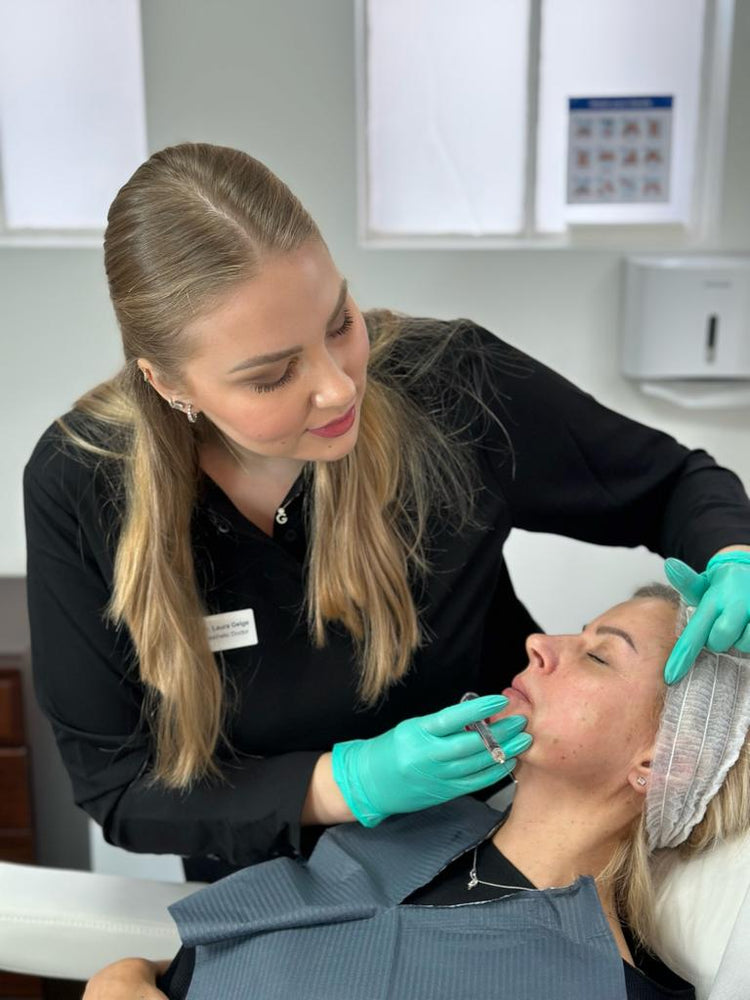Are Marionette Line Fillers Safe And Effective In London Clinics
Are Marionette Line Fillers Safe?
Marionette lines, those downward creases that appear between your mouth and chin, are a common sign of aging. For many, these lines can detract from their youthful appearance. Luckily, dermal fillers offer a potential solution to smoothing these wrinkles. But with any cosmetic procedure, safety is paramount. This article explores the safety and effectiveness of marionette line fillers in London clinics, providing you with the information needed to make an informed decision about this popular treatment.
Procedure Safety and Risks
Marionette line fillers are generally considered safe when administered by a qualified and experienced practitioner in a reputable clinic like those found in London. The most common type of filler used for marionette lines is hyaluronic acid, a naturally occurring substance in the body that provides volume and hydration to the skin.
As with any cosmetic procedure, there are potential risks and side effects associated with marionette line fillers. These can include bruising, swelling, redness, and tenderness at the injection site. In rare cases, more serious complications such as infection, allergic reaction, or vascular occlusion (blockage of a blood vessel) can occur. It’s crucial to choose a clinic with experienced injectors who follow strict sterilization protocols to minimize these risks.
To ensure safety and effectiveness, it is essential to have a thorough consultation with a qualified practitioner before undergoing any filler treatment. They will assess your individual needs, discuss your medical history and any medications you are taking, and advise on the most appropriate type of filler and technique for your specific case.
FDA Approval and Regulation in the UK
Marionette line fillers are generally considered safe when administered by a qualified and experienced practitioner in a reputable clinic. The UK has strict regulations governing cosmetic procedures, including dermal fillers.
- The Medicines and Healthcare products Regulatory Agency (MHRA) is the regulatory body responsible for approving and monitoring medical devices and treatments in the UK, including dermal fillers.
- To be legally used in the UK, dermal fillers must be approved by the MHRA.
- Practitioners administering fillers must also be registered with a relevant professional body, such as the General Dental Council (GDC) or the Nursing and Midwifery Council (NMC), and have the necessary training and experience.
By choosing a clinic that adheres to these regulations and employing experienced practitioners, you can minimize the risks associated with marionette line fillers and increase your chances of achieving a safe and successful outcome.
Choosing a Qualified Practitioner
Marionette line fillers are generally considered safe when administered by a qualified and experienced practitioner in a reputable clinic like those found in London. The most common type of filler used for marionette lines is hyaluronic acid, a naturally occurring substance in the body that provides volume and hydration to the skin.
As with any cosmetic procedure, there are potential risks and side effects associated with marionette line fillers. These can include bruising, swelling, redness, and tenderness at the injection site. In rare cases, more serious complications such as infection, allergic reaction, or vascular occlusion (blockage of a blood vessel) can occur. It’s crucial to choose a clinic with experienced injectors who follow strict sterilization protocols to minimize these risks.
To ensure safety and effectiveness, it is essential to have a thorough consultation with a qualified practitioner before undergoing any filler treatment. They will assess your individual needs, discuss your medical history and any medications you are taking, and advise on the most appropriate type of filler and technique for your specific case.
- Look for a practitioner who is a member of a reputable professional organization, such as the British Association of Aesthetic Plastic Surgeons (BAAPS) or the Joint Council for Cosmetic Practitioners (JCCP).
- Check if the clinic has proper licensing and accreditation.
- Inquire about the practitioner’s experience and training in administering marionette line fillers.
By choosing a clinic that adheres to these guidelines, you can minimize the risks associated with marionette line fillers and increase your chances of achieving a safe and successful outcome.
Effectiveness of Marionette Line Fillers
Marionette lines, those downward creases appearing between the mouth and chin, are a common sign of aging. Dermal fillers offer a potential solution for smoothing these wrinkles, but safety is paramount. This article explores the safety and effectiveness of marionette line fillers in London clinics, providing information to help you make an informed decision about this popular treatment.
Results and Longevity

Marionette line fillers are generally considered safe when administered by a qualified and experienced practitioner in a reputable clinic like those found in London. The most common type of filler used for marionette lines is hyaluronic acid, a naturally occurring substance in the body that provides volume and hydration to the skin.
As with any cosmetic procedure, there are potential risks and side effects associated with marionette line fillers. These can include bruising, swelling, redness, and tenderness at the injection site. In rare cases, more serious complications such as infection, allergic reaction, or vascular occlusion (blockage of a blood vessel) can occur.
To ensure safety and effectiveness, it is essential to have a thorough consultation with a qualified practitioner before undergoing any filler treatment. They will assess your individual needs, discuss your medical history and any medications you are taking, and advise on the most appropriate type of filler and technique for your specific case.
The UK has strict regulations governing cosmetic procedures, including dermal fillers. The Medicines and Healthcare products Regulatory Agency (MHRA) is responsible for approving and monitoring medical devices and treatments in the UK, including dermal fillers. To be legally used in the UK, dermal fillers must be approved by the MHRA. Practitioners administering fillers must also be registered with a relevant professional body, such as the General Dental Council (GDC) or the Nursing and Midwifery Council (NMC), and have the necessary training and experience.
By choosing a clinic that adheres to these regulations and employing experienced practitioners, you can minimize the risks associated with marionette line fillers and increase your chances of achieving a safe and successful outcome. Look for a practitioner who is a member of a reputable professional organization, such as the British Association of Aesthetic Plastic Surgeons (BAAPS) or the Joint Council for Cosmetic Practitioners (JCCP). Check if the clinic has proper licensing and accreditation. Inquire about the practitioner’s experience and training in administering marionette line fillers.
Results from marionette line fillers are typically noticeable immediately after treatment, with further improvement over the following few days as the filler settles. The smoothing effect can last for several months to a year or longer, depending on factors like the type of filler used and individual metabolism. Regular touch-up treatments are generally required to maintain the results.
Patient Expectations and Realistic Outcomes
Marionette lines, those downward creases appearing between the mouth and chin, are a common sign of aging. Dermal fillers offer a potential solution for smoothing these wrinkles, but safety is paramount. This article explores the safety and effectiveness of marionette line fillers in London clinics, providing information to help you make an informed decision about this popular treatment.
Marionette line fillers are generally considered safe when administered by a qualified and experienced practitioner in a reputable clinic like those found in London. The most common type of filler used for marionette lines is hyaluronic acid, a naturally occurring substance in the body that provides volume and hydration to the skin.
As with any cosmetic procedure, there are potential risks and side effects associated with marionette line fillers. These can include bruising, swelling, redness, and tenderness at the injection site. In rare cases, more serious complications such as infection, allergic reaction, or vascular occlusion (blockage of a blood vessel) can occur.
To ensure safety and effectiveness, it is essential to have a thorough consultation with a qualified practitioner before undergoing any filler treatment. They will assess your individual needs, discuss your medical history and any medications you are taking, and advise on the most appropriate type of filler and technique for your specific case.

The UK has strict regulations governing cosmetic procedures, including dermal fillers. The Medicines and Healthcare products Regulatory Agency (MHRA) is responsible for approving and monitoring medical devices and treatments in the UK, including dermal fillers. To be legally used in the UK, dermal fillers must be approved by the MHRA. Practitioners administering fillers must also be registered with a relevant professional body, such as the General Dental Council (GDC) or the Nursing and Midwifery Council (NMC), and have the necessary training and experience.
By choosing a clinic that adheres to these regulations and employing experienced practitioners, you can minimize the risks associated with marionette line fillers and increase your chances of achieving a safe and successful outcome. Look for a practitioner who is a member of a reputable professional organization, such as the British Association of Aesthetic Plastic Surgeons (BAAPS) or the Joint Council for Cosmetic Practitioners (JCCP). Check if the clinic has proper licensing and accreditation. Inquire about the practitioner’s experience and training in administering marionette line fillers.

Results from marionette line fillers are typically noticeable immediately after treatment, with further improvement over the following few days as the filler settles. The smoothing effect can last for several months to a year or longer, depending on factors like the type of filler used and individual metabolism. Regular touch-up treatments are generally required to maintain the results.
It’s important to have realistic expectations about the outcome of marionette line fillers. While they can significantly reduce the appearance of these lines, they cannot completely erase them.
- The best candidates for marionette line fillers are individuals with mild to moderate wrinkles who are looking for a subtle enhancement to their appearance.
- Patients with deep or severe wrinkles may require additional treatment options, such as surgery or more aggressive filler techniques.
Open communication with your practitioner about your desired outcome is crucial. They can help you determine if marionette line fillers are the right treatment for you and discuss the potential risks and benefits involved.
Comparing with Other Treatment Options
Marionette line fillers are a popular non-surgical option for smoothing the creases that appear between the mouth and chin, known as marionette lines. While they are generally safe when administered by qualified professionals, it’s essential to compare them with other treatment options to determine the most suitable choice for your needs.
Here’s a comparison of marionette line fillers with alternative treatments:
* **Botulinum Toxin (Botox):** Botox primarily works by relaxing muscles, which can help minimize the appearance of dynamic wrinkles (those that appear when you smile or frown). While it can indirectly affect marionette lines by reducing muscle contractions, it is not as effective as fillers for addressing static wrinkles (present even at rest).
* **Non-surgical Thread Lifting:** This technique uses biodegradable threads inserted beneath the skin to lift and tighten sagging tissues. Thread lifting can address marionette lines by providing support to the area, but results may not be as immediate or dramatic as with fillers.
* **Laser Treatments:** Certain laser therapies can stimulate collagen production and improve skin texture, potentially reducing the appearance of marionette lines over time. However, multiple sessions are often required, and results might not be as noticeable as with fillers.
Choosing the best treatment depends on individual factors such as the severity of the wrinkles, desired outcome, budget, and personal preferences.
Marionette line fillers offer a relatively quick and effective solution for smoothing these lines with noticeable results immediately after treatment.
Smooth away Nasolabial Folds with expert treatments from Dr. Laura Geige at It’s Me & You Clinic
- Botox Lip Flip In Cobham, Surrey - May 23, 2025
- Obagi Blue Peel Radiance Peel Near Richmond, Surrey - May 23, 2025
- How To Choose A Qualified Dermal Filler Practitioner In The UK - May 22, 2025
